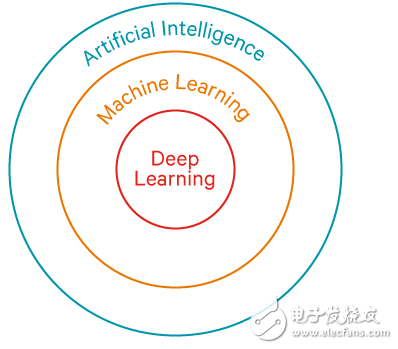Intelligent life is bridging the gap between us and the universe. From smart home devices to self-driving cars and smartphones, we encounter artificial intelligence (AI) every day. AI refers to the simulation of human intelligence in machines, allowing them to think, learn, and perform tasks that typically require human cognition. The term "artificial intelligence" was first coined by cognitive scientist John McCarthy in the 1950s. By giving machines a logical framework, they can mimic human behavior and decision-making processes.

You might have recently come across the terms "artificial intelligence," "machine learning," and "deep learning" used together, often interchangeably. While related, these concepts are not the same. To better understand their distinctions, let's compare them to apples and oranges—similar but clearly different. Artificial Intelligence, in its broadest sense, refers to any system that can perform tasks requiring human-like intelligence. These systems can recognize patterns, make decisions, or even interact with humans, all through a combination of software and hardware.

At its core, AI mimics human thinking, such as the ability to distinguish between an apple and an orange.
Machine learning is a subset of AI that focuses on enabling machines to learn from data rather than relying on explicit programming. Instead of being told exactly what to do, a machine uses algorithms to analyze large datasets, identify patterns, and make predictions. For example, if a system incorrectly classifies a cream puff as an orange, it can learn from this mistake and improve over time, much like a human would. This ability to adapt and improve without constant manual intervention is one of the key strengths of machine learning.

Machine learning allows systems to improve their performance through experience, especially in pattern recognition.
Deep learning is a more advanced form of machine learning that uses multi-layered neural networks to simulate the way the human brain processes information. It relies heavily on large amounts of data and computational power to identify complex patterns and relationships within that data. Unlike traditional machine learning, deep learning can automatically extract features from raw data, making it particularly effective for tasks like image and speech recognition. For instance, a deep learning model can analyze various attributes of a fruit—such as color, shape, size, and origin—to accurately classify whether it's a green apple or a blood orange.

Through deep learning, machines can process vast amounts of data, uncover hidden insights, and make highly accurate predictions. It’s the driving force behind many of today’s most impressive AI applications.
The distinction between AI, machine learning, and deep learning isn't always clear-cut, but they represent a hierarchy of capabilities. AI is the overarching concept, machine learning is a method within AI, and deep learning is a powerful subset of machine learning. Companies like Qualcomm are integrating these technologies into mobile platforms to create smarter, more intuitive devices that learn and adapt to user behavior over time.
Domestic communication, 4 g module in addition to support two kinds of LTE FDD LTE/TD - LTE standard, also compatible with 2 g / 3 g down, support td-scdma/WCDMA/EDGE/GP/GSM/CDMA1X/EVDO mode. The data service downstream rate can reach up to 100Mbps, the uplink rate can reach up to 50Mbps, providing customers with high-speed Internet access and wireless data connection and other functions. In addition to providing high-speed data access, it also provides voice, SMS, communication book and other functions, which can be widely used in notebook, tablet, touch screen communication devices, smart phones, video surveillance, multimedia mobile phones and vehicle equipment and other terminal products and vertical applications. Today, I will introduce you to what is 4G module and how to use 4G module.
What is 4G module
4G module said TD-LTE and FDD-LTE and other LTE network standards are collectively referred to. It has the characteristics of fast communication speed, wide network spectrum and flexible communication. 4G module refers to a product whose hardware is loaded to the specified frequency band, software supports the standard LTE protocol, and software and hardware are highly integrated and modular. The hardware integrates radio frequency and baseband on a small PCB board to complete wireless receiving, transmitting and baseband signal processing functions. The software supports voice dialing, SMS sending and receiving, dial-up networking and other functions.
Second, how to use 4G module
The 4G module is usually inserted into the circuit board or the patch module is welded to the circuit board, and the corresponding SIM card is inserted, and the network is connected through the 4G cellular network. In the common transparent transmission mode, data can be directly sent to the target server through the 4G module, and the 4G module can receive data from the server at the same time, and send the data to the serial port, which is received by the serial port device connected to the 4G module. Users do not need to pay special attention to the data conversion process between serial port data and network data packets, only need to insert the module to the target position, simple connection and parameter setting, you can achieve transparent transmission between the serial port and the network end.
What is the 4G module How does the 4G module work
4G module, also known as 4G transmission module, 4G communication module, 4G LTE module. It is a kind of hardware loaded to the specified frequency band, the software supports the standard LTE protocol, and the software and hardware are highly integrated modular products, with good compatibility, fast communication speed, large amount of communication data, wide network spectrum, communication flexibility and other characteristics, widely used in electric power, environmental protection, finance, industrial automation and other fields.
The working principle of 4G module
It has the characteristics of fast communication speed, wide network spectrum and flexible communication. The hardware integrates radio frequency and baseband on a small PCB board to complete wireless receiving, transmitting and baseband signal processing functions. The software supports voice dialing, SMS sending and receiving, dial-up networking and other functions.
Through high-speed networking, the 4G module transmits all terminal business data and equipment operating status to the business center in real time. Through the management monitoring platform, the terminal equipment operating status can be monitored in real time and equipment faults can be timely checked. The efficiency has been greatly improved in many aspects such as operating cost, operation scale and service timeliness. Suitable for shared massage chair, public charging pile, vending machine, vehicle system, environmental monitoring, power remote monitoring and other industries.
4G module refers to a product whose hardware is loaded to the specified frequency band, software supports the standard LTE protocol, and software and hardware are highly integrated and modular. It has the characteristics of fast communication speed, wide network spectrum and flexible communication. The hardware integrates radio frequency and baseband on a small PCB board to complete wireless receiving, transmitting and baseband signal processing functions. The software supports voice dialing, SMS sending and receiving, dial-up networking and other functions. Through high-speed networking, the 4G module transmits all terminal business data and equipment operating status to the business center in real time. Through the management monitoring platform, the terminal equipment operating status can be monitored in real time and equipment faults can be timely checked. The efficiency has been greatly improved in many aspects such as operating cost, operation scale and service timeliness.
Good compatibility
4G module supports FDD LTE/TD-LTE two LTE standards, can also be backward compatible with 2G/3G, support LTE-FDD, LET-TDD, WCDMA, TD-SCDMA, CDMA, GSM and other bands.
Large amount of communication data
4G module downstream rate can reach up to 150Mbps, uplink rate can reach up to 50Mbps, to provide customers with high-speed Internet access and wireless data connection and other functions, suitable for large data transmission applications, such as: remote video surveillance.
High communication speed
The 4G module has a lower ping value than the 2G/3G module, and it takes less time for the module to send data packets to receive the response from the server, which is suitable for applications requiring high response speed, such as remote alarm.
4G Module,4G Router Module,4G Wifi Module,4G Lte Wifi Module
Shenzhen MovingComm Technology Co., Ltd. , https://www.movingcommtech.com
![<?echo $_SERVER['SERVER_NAME'];?>](/template/twentyseventeen/skin/images/header.jpg)